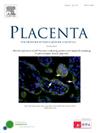Dysregulation of placental mitochondrial structure dynamics and clearance in maternal obesity and gestational diabetes
IF 2.5
2区 医学
Q2 DEVELOPMENTAL BIOLOGY
引用次数: 0
Abstract
Introduction
The placenta is exposed to an altered metabolic environment in obesity and gestational diabetes (GDM) leading to disruption in placental function. Mitochondria are critical for energy production and cellular adaptation to stress. We previously reported reduced trophoblast mitochondrial respiration in GDM. Here we examine changes in mitochondrial structure dynamics, quality and protein homeostasis as well as clearance in male and female placentas of pregnancies complicated by obesity and GDM. As obesity significantly increases the risk for GDM, our goal is to determine the distinct effects of each on placental mitochondria.
Methods
We collected placental villous tissue following elective cesarean section at term from lean (LN, pre-pregnancy BMI 18.5–24.9), obese (OB, BMI>30) or obese with type A2 GDM women. Expression of proteins involved in mitochondrial biogenesis, structure dynamics, quality control and clearance were assessed by Western blotting. Significant changes between groups were determined in fetal sex-dependent and independent manner.
Results
Only placentas from obese women showed increase in proteins regulating mitochondrial biogenesis (PGC-1α and SIRT1). We report fetal sex-specific changes in mitochondrial fusion but an overall decline in fission in OB and GDM placentas. Both maternal obesity and GDM affected proteins involved in maintaining mitochondrial protein quality and genome stability. This was accompanied by a reduction in mitochondrial complexes, suggesting impaired mitochondrial function. Obesity led to partial activation of mitophagy pathways (e.g., increased PINK1 without PARKIN activation), but GDM placentas failed to mount this response.
Discussion
Obesity and GDM affect placental mitochondria through distinct complex sex-specific mechanisms that may contribute to altered mitochondrial function.
胎盘线粒体结构动力学和清除失调在产妇肥胖和妊娠糖尿病
在肥胖和妊娠糖尿病(GDM)中,胎盘暴露于改变的代谢环境中,导致胎盘功能破坏。线粒体对能量产生和细胞适应压力至关重要。我们之前报道过GDM中滋养层线粒体呼吸减少。在这里,我们检查线粒体结构动力学,质量和蛋白质稳态的变化,以及清除在男性和女性胎盘合并肥胖和GDM。由于肥胖显著增加GDM的风险,我们的目标是确定每一种对胎盘线粒体的不同影响。方法我们收集瘦(LN,孕前BMI 18.5-24.9)、肥胖(OB, BMI>30)或肥胖合并A2型GDM的足月选择性剖宫产术后胎盘绒毛组织。Western blotting检测线粒体生物发生相关蛋白的表达、结构动力学、质量控制和清除率。各组间胎儿性别依赖和性别独立差异显著。结果只有肥胖妇女胎盘显示调节线粒体生物发生的蛋白(PGC-1α和SIRT1)增加。我们报道了胎儿性别特异性的线粒体融合变化,但OB和GDM胎盘的裂变总体下降。母亲肥胖和GDM都影响维持线粒体蛋白质量和基因组稳定性的蛋白质。这伴随着线粒体复合物的减少,表明线粒体功能受损。肥胖导致有丝分裂途径的部分激活(例如,PINK1增加而没有PARKIN激活),但GDM胎盘未能产生这种反应。肥胖和GDM通过不同复杂的性别特异性机制影响胎盘线粒体,可能导致线粒体功能改变。
本文章由计算机程序翻译,如有差异,请以英文原文为准。
求助全文
约1分钟内获得全文
求助全文
来源期刊

Placenta
医学-发育生物学
CiteScore
6.30
自引率
10.50%
发文量
391
审稿时长
78 days
期刊介绍:
Placenta publishes high-quality original articles and invited topical reviews on all aspects of human and animal placentation, and the interactions between the mother, the placenta and fetal development. Topics covered include evolution, development, genetics and epigenetics, stem cells, metabolism, transport, immunology, pathology, pharmacology, cell and molecular biology, and developmental programming. The Editors welcome studies on implantation and the endometrium, comparative placentation, the uterine and umbilical circulations, the relationship between fetal and placental development, clinical aspects of altered placental development or function, the placental membranes, the influence of paternal factors on placental development or function, and the assessment of biomarkers of placental disorders.
 求助内容:
求助内容: 应助结果提醒方式:
应助结果提醒方式:


